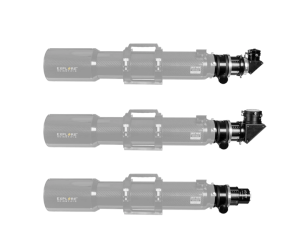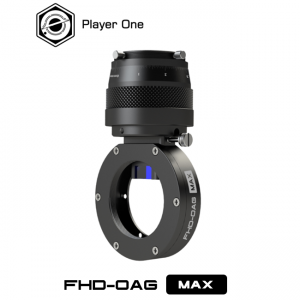With its ability to support heavy imaging trains without sacrificing stability, precision or smooth rotation, the new, robust Explore Scientific 3-inch Self-Centering Focuser is designed to meet the demanding requirements of astrophotography. As a side note, we get emails daily about product mentions in forums focusing on astronomy products and one came across with the comment, “Man oh Man is she a beautiful thing…” And we have to agree, although when we saw it we thought, “What a monster of a focuser!”
 The Explore Scientific 3-inch Self-Centering Focuser is an extremely robust focuser which has a self-centering compression system that applies pressure equally to the draw tube, guaranteeing a tight, secure fit. This uniform pressure creates a stable base for an imaging setup and prevents flex, tilt and image shift. The draw tube, which is long enough to eliminate the need for extension tubes, is moved by a helical rack-and-pinion system lubricated with marine-grade PTFE silicone for an easy glide with maximum precision and minimal backlash. The interior of the draw tube has a diameter of 3 inches that is lined with multiple baffles to reduce reflection.
The Explore Scientific 3-inch Self-Centering Focuser is an extremely robust focuser which has a self-centering compression system that applies pressure equally to the draw tube, guaranteeing a tight, secure fit. This uniform pressure creates a stable base for an imaging setup and prevents flex, tilt and image shift. The draw tube, which is long enough to eliminate the need for extension tubes, is moved by a helical rack-and-pinion system lubricated with marine-grade PTFE silicone for an easy glide with maximum precision and minimal backlash. The interior of the draw tube has a diameter of 3 inches that is lined with multiple baffles to reduce reflection.
The draw tube, which has a travel of 84.5mm, is supported by a locking clutch system. The focusing system has a lifting capacity of 17 pounds. Moderate tightening offers an infinite range of tension to best suit the application. Weighing in at 5.7 pounds, the focuser is made of black anodized aluminum. It has a 9:1 focus system with stainless-steel ball bearings and stainless-steel focus shaft. This system works as a clutch to prevent damage to the focusing mechanism. The focusing system is compatible with popular after-market electric focuser devices.
 A back cell adapter with no-tool knobs attaches the focuser at four contact points to select Explore Scientific refractors with apertures ranging from 120mm to 140mm. The knobs on the adapter can be hand turned, eliminating the need for a hex key. This makes it easy to adjust the rotation of the focuser with minimal observing or imaging interruption. A Teflon ring on the focuser adds to the smooth rotation. The Explore Scientific 152mm and 165mm models do not require this back cell adapter. And custom back cells are available on request for other brands of refractor telescopes 120 mm and larger.
A back cell adapter with no-tool knobs attaches the focuser at four contact points to select Explore Scientific refractors with apertures ranging from 120mm to 140mm. The knobs on the adapter can be hand turned, eliminating the need for a hex key. This makes it easy to adjust the rotation of the focuser with minimal observing or imaging interruption. A Teflon ring on the focuser adds to the smooth rotation. The Explore Scientific 152mm and 165mm models do not require this back cell adapter. And custom back cells are available on request for other brands of refractor telescopes 120 mm and larger.
For versatility, the focuser can hold 2-inch or 3-inch visual or camera accessories and comes standard with twist-lock. In addition to allowing accessories to be secured with a compression fitting, this draw tube’s M82 x 1.25 pitch thread accepts adapters with a variety of uses.
The Explore Scientific 3-inch Self-Centering Focuser specification include:
– Lifting Capacity: 17 lbs/37.4 kg
– Draw Tube Thread: M82 x 1.25
– Draw Tube Travel: 84.5 mm/3.32 inches
– Draw Tube Clear Interior Diameter: 76.2 mm/3 inches
– Draw Tube Baffles: 14
– Focus System: Helical rack & pinion
– Reduction Ratio: 9:1 with stainless steel ball bearings and shaft
– Attachment Mechanisms: Self-centering compression
– Weight of Focuser: 5.7 pounds including the 3-inch to 2-inch twist-lock adapter
– Compatible with Electric Focusers: Yes
– Telescope Compatibility: Explore Scientific refractor telescopes 120 mm and larger; custom back cells available on request for other brands of refractor telescopes 120 mm and larger.
You can view a video overview of the new focuser below.
You can learn more about the Explore Scientific 3-inch Self-Centering Focuser here.
And to make it easier for you to get the most extensive news, articles and reviews that are only available in the magazine pages of Astronomy Technology Today, we are offering a 1-year magazine subscription for only $6! Or, for an even better deal, we are offering 2 years for only $9. Click here to get these deals which only will be available for a very limited time. You can also check out a free sample issue here.
The sun is more active than it has been in years! If you’d like to learn more the technology behind solar observing, solar imaging and more, you can check out our free publication, “The Definitive Guide to Viewing and Imaging the Sun”. You don’t have to sign up or provide any information, simply click here and enjoy reading!



